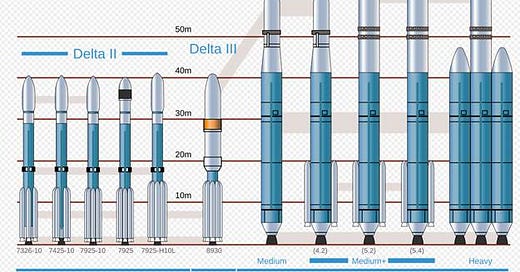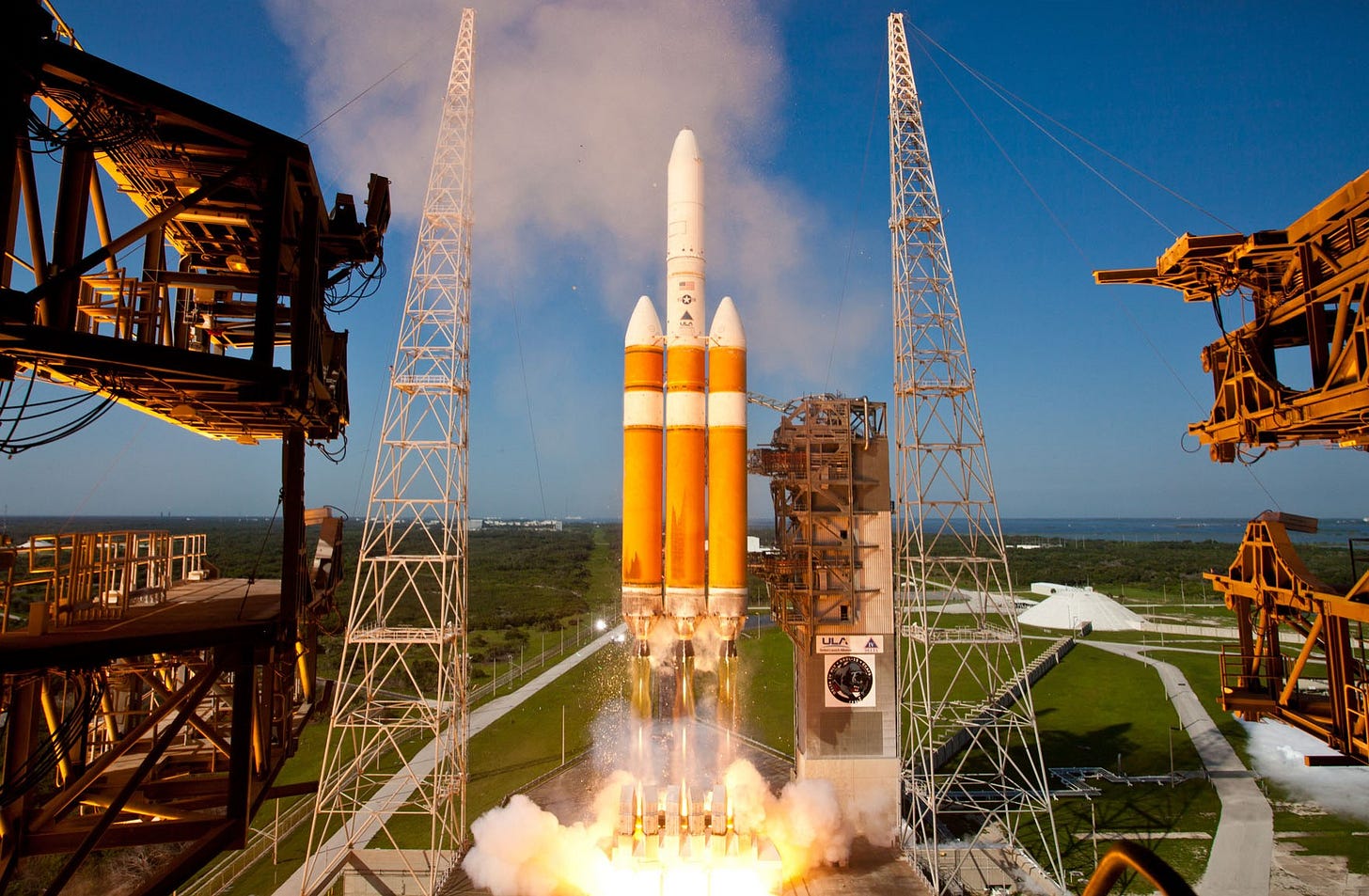The Delta Launch Complex Comes Down, It Gets Real-er, Thoughts On When You Stay
Thanks to: Space Prom, Morgan Kopecky, Robert Lightfoot, the Delta rockets, NASA's study of rocket failure rates, Bryce Tech and SIA, Bob Dylan, the people of WFF -- those who stayed and who left
The Stable Where the Workhorses Used To Live
You will have to bear with me on this one. Even I don’t know exactly where it is going, but I saw a news article that just was overwhelming in terms of its impact and the sheer amount of context that, in my view, should be shared.
In 2019 I went to dinner. I was all dressed up because I was at the “Space Prom”. That term, “space prom” is the term used for the annual awards dinner thrown by the National Space Club in Washington DC. It is a surreal event to attend if you are “in the business”. If you ever go, you will be crammed into a room with 2,000 or so people who, literally, could (and in most cases actually have) designed, built, tested, and flown, the most complicated aerospace missions, science instruments, and launch systems, known to humankind. And the weird thing is, they are all in suits! Yes, there are a few pocket protectors, but for the most part it was straight up suits and tuxedos. To be brutally honest, it was hard to recognize some of the people I had worked with for decades and, in many cases, had seen earlier on that very day.
Anyway, I remember a few things from that night. I remember how cool it was that the keynote speech was given, not by one of the luminaries from the industry, but instead by Ms. Morgan Kopecky, a high school student who had lead a student team that designed, built, launched, and operated, a small swarm of cubesats. (Where ever you are, Morgan, I hope you are doing well.) I remember that my one – time direct boss, Robert Lightfoot, received an award. When I ran into him later in the evening he looked at my wife and said, “Thank you for letting us borrow him for a couple of years.” Somehow it was the perfect comment.
But the thing I remember most of all was what happened when an award was presented for the work done on the Delta-II rocket. What happened was that everyone stood up and applauded wildly, and if you watched closely, what people were clapping for, even cheering wildly for, was the rocket. Maybe I am seeing this as a launch guy, a “range rat”, but I can tell you that however long we stood up, however long we clapped and cheered, that rocket deserved it. We all, everyone in there, knew that the Delta II had had over a hundred consecutive successful launches and only one total failure in more than 150 launches. It was a beast of a rocket and many dozens of people in that room had seen their work … their dreams … rise into the sky because of the excellence, reliability, and capability of that rocket. I saw a couple people, and I am not joking, wipe away a tear as they clapped. We clapped so long that it got weird that we were still clapping and then we kept clapping until it was no longer weird, just joyous. It was a beautiful thing, a simple joyous tribute from 2000 dressed up space nerds who knew how specialized and niche their appreciation really was. And it was all for a rocket.
What sparked this thought was this article that describes the demolition of Launch Complex 37, the launch site for the successor to the Delta II, the Delta IV and its variant, the Delta IV Heavy pictured above. Between them, these two rockets, the II and the IV lofted payloads into space more than 200 times. For a long time, they were the only thing that was even qualified to get an important payload up there. Those rockets accommodated everything during a time when there was far less standardization of payloads than there is now. Their failure rates were astonishingly low, particularly in the early parts of their development cycle when failure rates are typically above 20%. They just did the job. “Legendary” is a term that is not too large for the Deltas.
So, just a tip of the hat to the Delta rocket family. I could go on and on about this rocket, but fortunately, this guy has already done it, so for those range rats still out there, this article has a ton of deep history about the origins and accomplishments of the Delta rockets. They were the workhorse rockets that carried the nation into space for more than 60 years (1960 - 2024). It is very safe to say (and I know this because I still know and talk to the people) that many many MANY of the new rockets we see today are developed, at least in part, by those who had some role on the Delta family.
On A Harsher Note
The reality of cuts to the nation’s civil space program is becoming clearer. In short, there looks to be no dramatic rescue of those budgets, and all NASA centers are gearing up for the loss, substantial loss in most cases, of contract and civil servant personnel. The civil servant losses will likely range between 20% and 40% once all is said and done.
The agency’s leaders have managed to create opportunities for voluntary departures in advance of any forced RIFs (reductions in force), and are actively encouraging those who are eligible (especially those with longtime eligibility) to take those options when their personal situation makes sense as this will perhaps lessen the RIF blow when it comes later with agency restructuring to align with the budget.
I put a lot more about this topic on The Organizing Thought just yesterday (and in prior posts) for those interested in some of the specifics. I certainly welcome your readership there, and while there is some commonality on topics at present, my intent there is to focus more on detailed organizational things and leadership stuff.
The one thing I really do want to stress is the conclusion that, I think, rests in this chart.
Contrary to what it feels like, the total amount spent on civil space technology and space science is actually still in a decently strong uptrend. I talked about this a lot in my recent posts both here and at the other site. I say this here to stress my view that there will very likely be sufficient work for those with technical, scientific and programmatic expertise related to space. The US commercial space sector is hungry for that workforce and has the money and customer base to absorb it. The US defense/intelligence establishment is likewise hungry for that workforce and has the money and mission to absorb it. But such disruptions are never smooth in the near term, and I don’t, in any way, mean to make it sound that way.
Again, for detailed discussion of my view of the current state of things, see The Organizing Thought.
What Comes When You Stay In the Face of A Storm
Lastly, I want to offer a word to those who already know they are NOT choosing to leave NASA. This group may have many reasons for staying – devotion to agency and mission, perceived lack of good choices, resistance to change, surety of a continued utilization of their skills, and many more … all valid, all fine – just like the reasons for leaving, by the way.
The thoughts I offer here are from experience, from being at a campus (we called it a ‘base’ and this says a lot more than it would seem at first glance but that is another story). We had been straight up told we were going to close but managed a last minute legislational reprieve (that is unlikely to come this time). But many people chose to leave, to take other offers or to simply retire rather than go through all that. I had no special insight but determined that I would stay. Here is some things I learned from that.
· You can’t, in any way, hold it against anyone who leaves. Just like yours is a personal reason, so is theirs. Count it as blessing that you got to work with them and remember that the space industry is, in context, tiny, so you will see them again.
· Similarly, and this will sound odd, you can’t hold it against anyone who stays. There will be times when it seems like “all the good ones are leaving”, but on other days, trust me, you will think “Thank God Person X was still here”, since it will seem that much memory has been lost and it will be a relief sometimes to be with those who share yours.
· Expect therefore, to find an amazing level of camaraderie with those who choose to remain, even if they don’t stay forever. I will spare you the 12 minutes of Bob Dylan’s “Brownsville Girl” and just offer the quote: “Strange how people who suffer together have stronger connections than those who are most content.” (the quote is at the 9:00 minute mark, right after the awesome saxophone part that starts at 8:00)
· Most importantly is this: the organization that comes after the dust settles will be stunningly different from the one that went in, and you, by virtue of the perspective you have, will be a leader in it. This leadership role may be formal or informal, and your wanting or not wanting it won’t matter at all. The fact is that you will be one of the ‘survivor generation’ and that will convey far more influence than you can imagine right now. The only error you can really make in the use of this influence would be if you tried to recreate exactly what had been before the storm. That will never be in your power to achieve.
· Opportunity will abound … in time. The pace of things will be very strange. As you know, things have seemed ‘relatively stable for a long time’, but now there is this ‘event’ where, once it is done, you will feel like everything changed in a moment. Once it passes, it will take the organization some time to find its feet, to figure out what it is about, its strengths and weaknesses, and how it fits into things. As this starts to happen, the very fact of your perspective and experience will be a part of the value that you bring and will enable you, formally or informally, to shape the future of the organization.
That’s enough for now.
Please put yourself first … ahead of the agency, the project, the mission, or whatever. Do the thing that feels right for you, whatever that is. You matter that much.
Stay sane,
J






